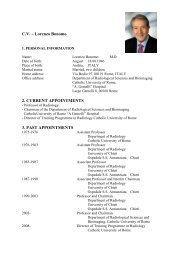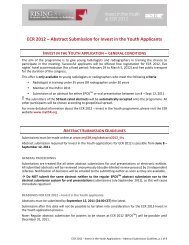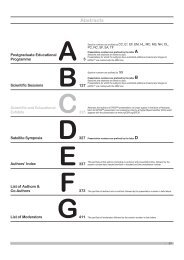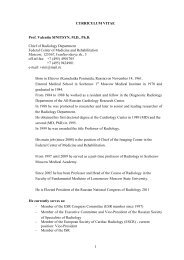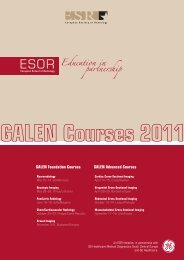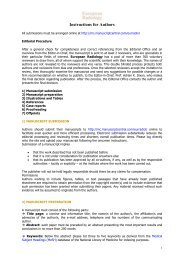Postgraduate Educational Programme - myESR.org
Postgraduate Educational Programme - myESR.org
Postgraduate Educational Programme - myESR.org
- No tags were found...
You also want an ePaper? Increase the reach of your titles
YUMPU automatically turns print PDFs into web optimized ePapers that Google loves.
<strong>Postgraduate</strong> <strong>Educational</strong> <strong>Programme</strong>bachelors, it is to be expected that related work fields, such as echocardiography,gynaecology and obstetrics, vascular ultrasound, musculoskeletal ultrasound andultrasound in private practice will be performed by radiographers in the near future.A continuous adjustment of ultrasound education is therefore essential.Learning Objectives:1. To learn about US education over an entire four year bachelor programme.2. To understand the role of the radiographers as a result of this bachelor programme.3. To appreciate changes in the education programme following changes in therole of the radiographers.Panel discussion:What are the challenges and barriers facing role extension? 17:1416:00 - 17:30 Room F2Special Focus SessionSF 7bImaging and radiotherapy: all you need to knowA-171 16:00Chairman’s introductionV.J. Goh; London/UK (vicky.goh@kcl.ac.uk)In this session, “Imaging and radiotherapy: all you need to know” the audiencewill have a comprehensive overview of the rationale for radiotherapyin cancer, current state-of-the-art planning and delivery of radiotherapy incancer patients, and evaluation of the treatment response and radiotherapyeffects. Following this session, the audience have insight into how developmentsin imaging may have contributed to improved outcomes in radiotherapy.Session Objectives:1. To understand the principles of modern radiotherapy.2. To learn how functional and metabolic imaging have been integrated intoradiotherapy planning, adaptation and response evaluation.3. To become familiar with imaging findings after radiotherapy.4. To understand how imaging affects radiotherapy outcomes.Author Disclosure:V. J. Goh: Research/Grant Support; Siemens.A-172 16:05Modern radiotherapy: what are the new technologies?V. Valentini; Rome/IT (vvalentini@rm.unicatt.it)Modern radiation oncology offers to cancer patients a safe, <strong>org</strong>an sparing, costeffective,well-validated treatment. Nowadays, radiation can be modulated in thefour dimensions of space and time, and the dose can be precisely defined toproduce a specified local effect of a given magnitude. The administration of nonuniformintensity-modulated radiotherapy (IMRT) to patients as a way to create aspecified, non-uniform absorbed dose distribution that provides better conformalityaround the tumours and increasing the amount of spared surrounding <strong>org</strong>ans.The optimal implementation of IMRT requires effective control of the tumour’slocation as well as of the changes in tumour volume during the daily treatment.Image-guided radiation therapy (IGRT) aims at in-room imaging guiding the radiationdelivery based on instant knowledge of the target location. The combinationof diagnostic tools and radiation intensity modulated technology is providing newgeneration of hybrid machine, suitable to offer this new service. The effectivenessand convenience for the patient to practice high dose delivery in few fractionsthrough stereotactic body radiotherapy (SBRT) implies optimal reduction of treatmentmargins, practical implementation of sharp dose gradients and interactiveadaptation of the treatment based on IGRT modalities. Its efficacy and feasibilityenlarged the offer of SBRT to different clinical conditions, where small volumeshave to be treated in primary or also in oligometastatic setting. The conformalityand reliability of dose delivery provided by new technology and imaging integrationpromoted new onset of clinical benefit and more affordability of cure to addressthe aging of cancer patient population.Learning Objectives:1. To become familiar with 3D conformal radiotherapy and intensity modulatedradiation therapy (IMRT) and intensity modulated radiosurgery (IMRS).2. To learn about brachytherapy and intraoperative radiotherapy (IORT) and itsindications.3. To understand how IMRT contributes to better treatment outcomes as comparedwith conventional radiotherapy.A-173 16:23PET/CT for radiotherapy planning: how does it assist IMRT?A. Loft; Copenhagen/DK (annika.loft@rh.regionh.dk)In Radiotherapy, the use of PET/CT scans for dose planning is increasing. On thePET images, the viable tumour can be delineated as a support for the delineationperformed on the corresponding CT. Small malignant foci are detected and canincrease the Gross Tumour Volume- oppositely, non-malignant but on CT pathologicalstructures can be left out- of course at the discretion of the oncologist!Especially for IMRT, the tumour delineation must be very precise. This demandsthat the patient is prepared for therapy planning with use of fixation equipmentfor correct positioning and that the staff is well trained and collaborate with thestaff from Radiotherapy when PET/CT scanning these patients. The collaborationacross specialities, the technical issues, the tumour delineation process and theclinical impact are discussed.Learning Objectives:1. To learn about anatomical imaging risk compartments that define gross tumourvolume (GTV).2. To understand how PET/CT assists in delineating the GTV.3. To understand the role of PET/CT guided IMRT and how it can lead to treatmentadaptation.A-174 16:41Response evaluation and treatment adaptationK. Haustermans; Leuven/BE (karin.haustermans@uzleuven.be)Multimodal imaging is becoming more important in radiotherapy planning anddelivery especially in the curative setting. Typically, before the start of a radiationtreatment, a CT scan in the treatment position is taken. On this CT scan, the clinicaltarget volume, the gross target volume and the <strong>org</strong>ans at risk are delineated.However, soft tissue contrast on CT scan is low, that is why MRI is often used aswell. MR images are then registered to the CT scan as the HU are needed to calculatethe dose distribution. Also PET with different tracers and DW MR are underevaluation in the radiation treatment preparation process. These functional imagingmodalities allow to depict more radioresistant areas within the tumour. Theoretically,a dose escalation to radioresistant subregions within the tumour becomespossible also thanks to the evolution in the technology to deliver the radiation.Several Phase II studies are ongoing to evaluate the benefits of an inhomogeneousdose distribution. Reimaging during a course of treatment allows to adapt thedose distribution, and this is called adaptive radiotherapy. Moreover, the changesmeasured on functional imaging performed during treatment, for example, changesin ADC values and/or SUV max are often predictive for treatment outcome. Overall,there is a rapid evolution in the integration of multimodal imaging in the radiationtreatment process which will lead to a more personalized radiation treatment andto better patient outcome with higher chances of local control and less side effects.Learning Objectives:1. To understand the molecular tumour microenvironment (tumour hypoxia,-apoptosis and -proliferation) that may impact response to radiation treatment.2. To learn how tumour heterogeneity, reflecting tumour microenvironment, influencesdose distribution in IMRT.3. To learn how response assessment during IMRT leads to adaptation andtailoring of radiation treatment.A-175 16:59MR imaging biomarkers for response evaluationR.G.H. Beets‐Tan; Maastricht/NL (r.beets.tan@mumc.nl)Imaging plays a pivotal role in cancer diagnostics and therapy monitoring. Magneticresonance imaging (MRI) stands out from other imaging modalities as a high-spatialresolution technique with superior soft-tissue contrast, which enables anatomic,functional as well as metabolic characterisation of the lesions. Anatomical informationon itself is invaluable but not sufficient to understand the biological profile ofthe tumour. With nowadays cancer specific treatment, non-invasive assessment oftumour biomarkers is highly desired to predict outcome of anti-cancer treatment.The most widespread method of non-invasive assessment of imaging biomarkersis functional imaging: perfusion dynamic contrast-enhanced MRI and diffusionweighted MRI. This lecture will elaborate on the value of perfusion and diffusion MRimaging for assessment of response after radiation treatment and for predicting ofresponse during radiation treatment. The audience will learn whether the imagingbiomarkers derived from such MR techniques enable a reliable stratification oftreatment and patient specific adjustment of radiation treatment.S44AB C D E F G




